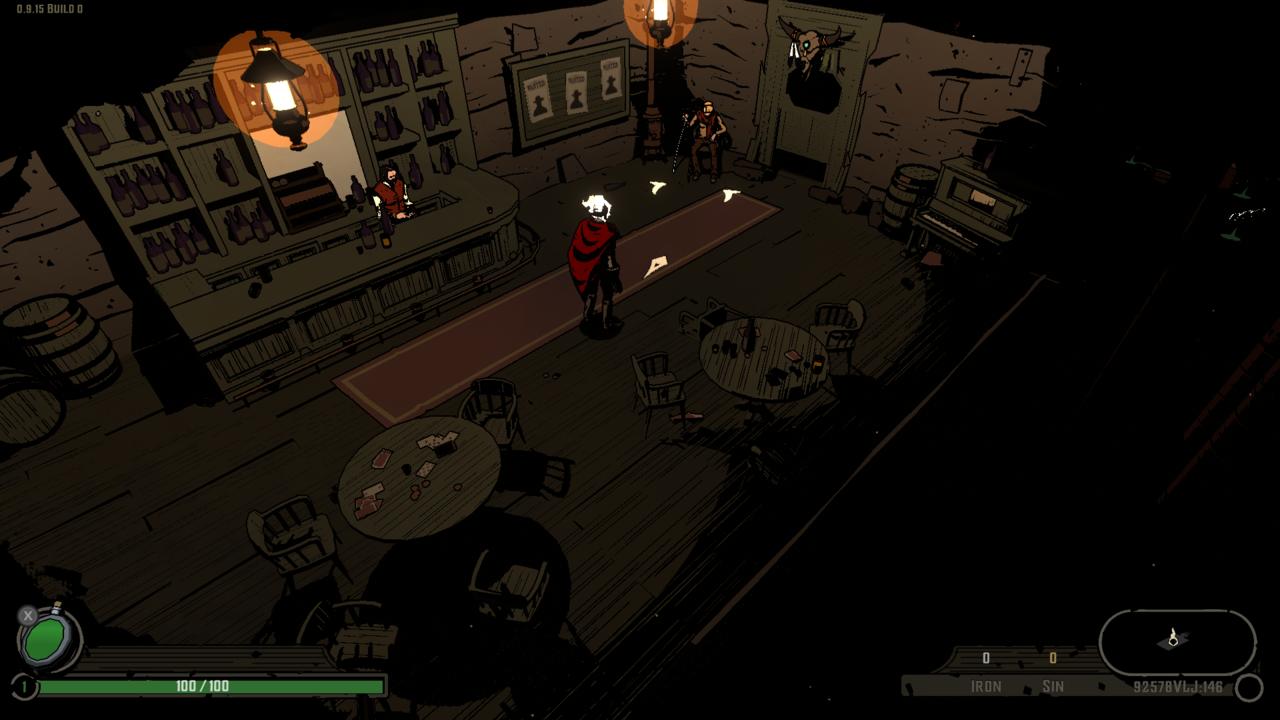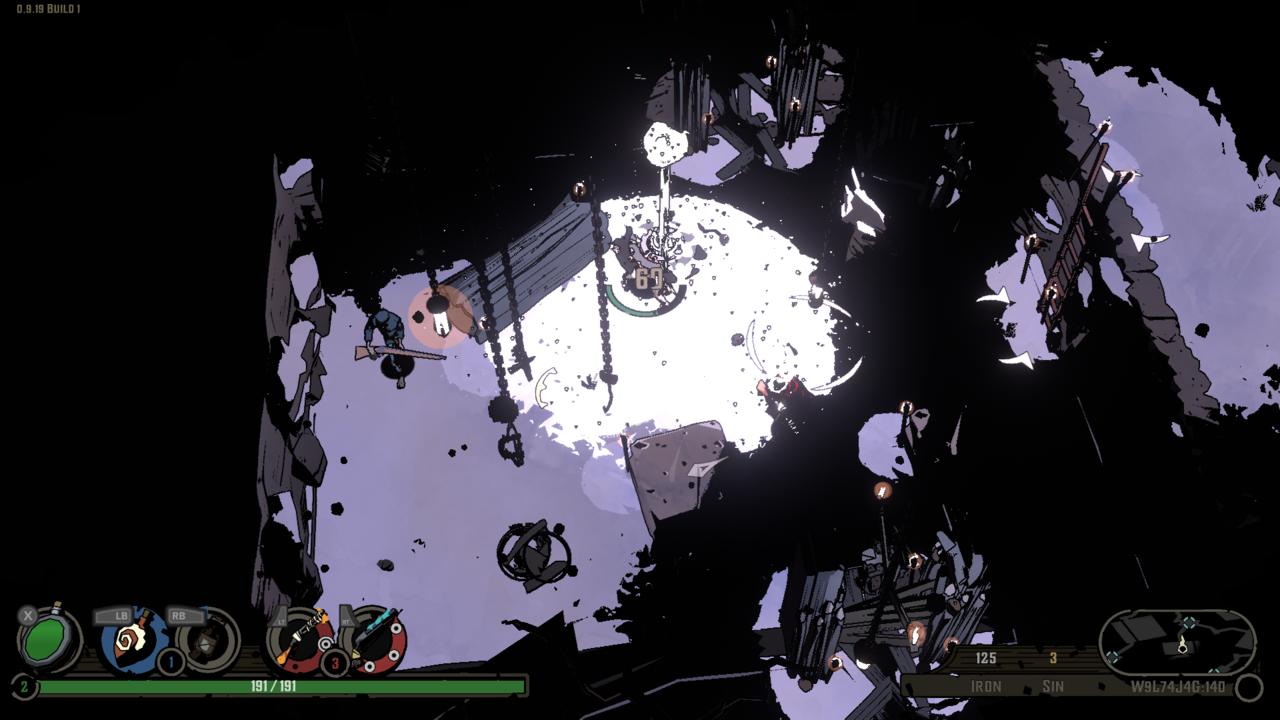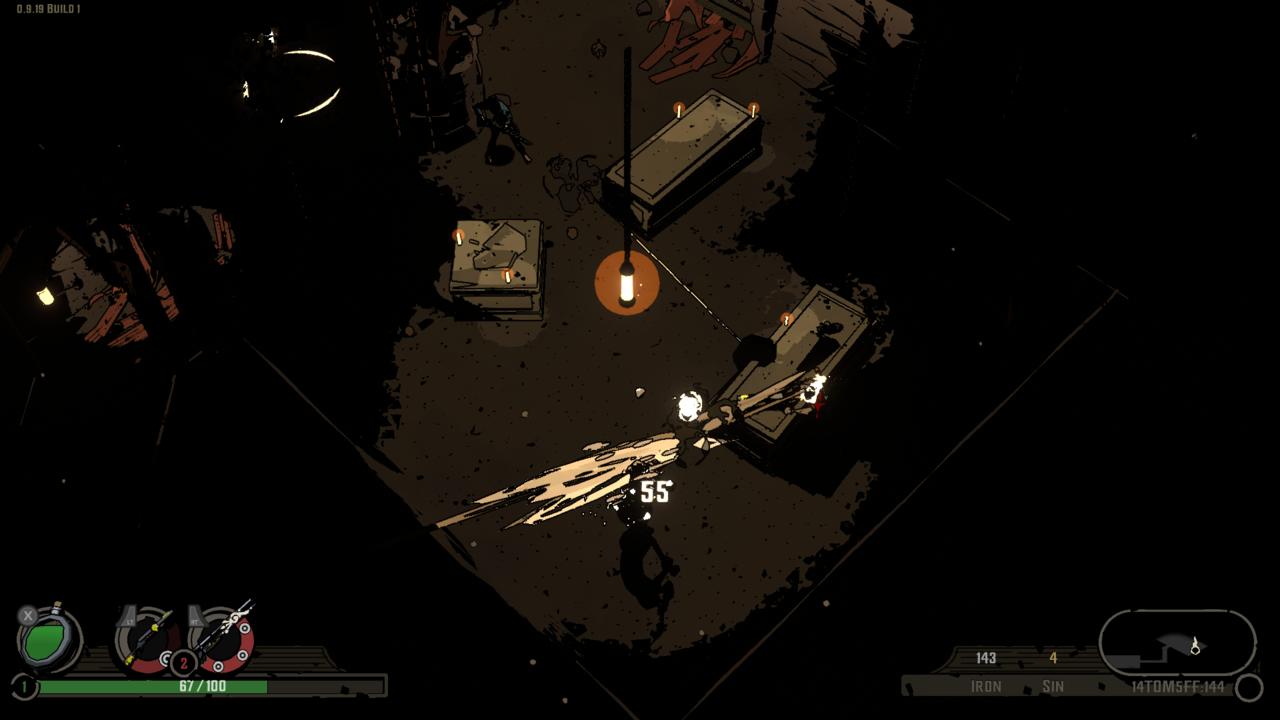West of Dead brings some interesting ideas to the well-trod Rogue-lite scene, but lots of technical and design flaws make it hard to enjoy them.
here are a lot of reasons to take a look at West of Dead. Cowboys and Wild West aesthetics are hot in games right now, in the wake of Red Dead Redemption 2. Run-based games are, likewise, very much a structure du jour. It’s dusted with voiceover narration from Ron Perlman, who you might know from Guillermo Del Toro’s Hellboy films or the FX TV Show Sons of Anarchy. And it certainly doesn’t hurt that its core mechanical conceit, as a cover-based twin-stick shooter, helps Frankenstein it to original and, dare I say, innovative gameplay. Unfortunately, West of Dead is a textbook case of a half-baked concept: Though its big sweeping ideas work well, the minutiae, from scaling the difficulty of encounters to unrefined enemies and plain old technical issues, threaten to undo the experience at any time.
West of Dead’s conceit builds up a simple but interesting little tale. In Purgatory–which is apparently in Wyoming–the dead have stopped filtering “east” to heaven or “west” to hell. You play an undead cowboy called the Marshall who’s lost his memory, save for his mission to kill the evil preacher holding up the afterlife. Though it’s more narrative glue than captivating storytelling, the Marshall’s inner monologue, in subdued performance from Perlman, keeps the story in mind, evoking a world that you might not see in its generic, monotonous Wild West-themed levels.

Like so many of today’s Rogue-inspired games, the story naturally falls away at a certain point, as you play and replay the game over and over, attempting to reach your goal. West of Dead retains many of the tropes established by the many, many rogue-lites that have launched in the last few years, and it cribs its structure specifically from 2018’s wildly successful version, Dead Cells. West of Dead procedurally generates long levels, which are punctuated with a store where you must spend Sin points to permanently expand your arsenal of weapons. In each run, you find upgrades to your specs and more powerful gear–two weapons, two accessories, and a passive charm. By defeating optional bosses, you gain access to branching paths with harder levels. You carry an upgradable healing flask, which you refill between levels. There’s even a hall at the start of each run where you can see all the weapons and upgrades you’ve bought. Though it comes dangerously close to getting branded as a “Dead Cells clone,” using familiar structure makes it easy to focus on West of Dead’s combat, where its real innovations lie.
Not everything works as well, though. The game’s procedural generation feels uneven. There are clear phases in every version of every level–rooms to introduce new enemies, or where you’re supposed to find an upgrade–that appear identical (or close to it) in every run. For example, the first fight in each level has the same enemies every time. At the same time, certain elements, like enemy placement, feel completely random, to the point where you may die at the hands of bad luck instead of poor play.
West of Dead builds a novel run-based experience from the bones of two less commonly used structures, twin-stick and cover-based shooters. The twin-stick element is purely mechanical–you use the left on your controller to move and the right stick to shoot. Like many twin-stick games, enemies will look to spread out and flank you, so it’s important to keep your head and your sights on a swivel.
How you shoot is dictated, in part, by what kinds of guns you use. There are four types–pistols, revolvers, shotguns, and rifles–which have different ranges and do different amounts of damage. In addition, each individual gun has its own quirk: Some make enemies take damage over time, for example. The differences among the guns and secondary weapons, which include explosives, throwing knives, and a few defensive items, don’t make a huge impact on their own, but they can make a difference if you choose gear to fit a specific strategy.

The cover shooter component is more pervasive. Each level is actually a series of combat arenas, conjoined by long hallway safe rooms. The arenas are spartan, but always feature a few boxes, bales of hay, or other places for you to take cover. Using cover puts you at a strong advantage–enemies cannot hit you while you’re even partially behind it, and you reload faster. By contrast, you’re extremely vulnerable when moving around in the open. Gun-toting enemies will hit their marks unless you dodge them, and it only takes a few shots to bring you down.
Given that cover is so important, though, there are many, many things designed to keep you from setting up in one spot and picking off enemies at your leisure. All cover is destructible, and most fights feature at least one enemy that will try to keep you moving. Making cover so desirable, but hard to hold onto creates urgency in every moment. Learning how to efficiently stop, dodge, or delay each enemy’s attack while making openings for yourself requires an understanding and level of skill that grows as you run and re-run the levels again and again. Even more so when you take into the account that you’ll have a different set of weapons, with their own strategic quirks, every time.
In a vacuum, these are the makings of a great rogue-lite, but the experience often fails to reach its potential because of design decisions, large and small, that make it hard to appreciate the dynamic between tactical thinking and quick, accurate shooting.

Though there are many problems, most of which seem small and specific, they’re compounded by the procedural generation issues so that playing well can only get you so far. A number of enemies that have wind-up attacks, where an indicator shows where they’ll hit, can change the direction of their attack after telegraphing it (which defeats the purpose of showing the indicator). The aim-assist mechanic, which targets enemies when they’re in a well-lit part of the room and ignores them when they’re in the dark, will target random spots on a wall rather than allowing you to free aim at targets in the dark. There’s nothing more annoying than lining up a shot, then seeing it go in another direction. Diverted shots, cheap hits, a bad roll of the procedural design dice–too often, it feels like the universe is working against you.
These problems hurt even more in the second half of the game, when the difficulty ramps up. Late-game enemies have more health than the enemies that came before, making it nearly impossible to dispatch even one without multiple scrambles for precious little cover. It’s especially annoying when fighting enemies who can teleport, making cover completely useless and destroying the dynamics of the cover system itself. Depending on the map, there were runs where it was easier (and less painful) to run past all the enemies than play through a series of long, drawn-out firefights.
…the experience often fails to reach its potential because of design decisions, large and small, that make it hard to appreciate the dynamic between tactical thinking and quick, accurate shooting.
Not all of these problems are intentional. Even after multiple patches, there are loads of repeating bugs. I’ve seen bullets pass through suicide-bombing enemies, demon dogs bite through walls, and any number of frustrating, often run-ending glitches. Given how fragile the Marshall is, any glitch that leads to damage, especially in the later levels, can spoil a run. When it happens once, it’s a disappointment. When it seems to happen every few runs, it’s a significant problem.
All of these things together turn a game that feels like it’s meant to take 10 to 15 hours to master into a much longer slog. After playing the game for more than twice that amount of time, I never achieved a winning run, but there’s not much left to see or conquer. The game’s NPCs say the same exact lines at the start of every run. It becomes a drag to re-run facsimiles of the same levels again and again: They’re similar enough that it feels like you have them memorized, even if the details change. When you spend too long in Purgatory, it starts to look a lot like hell.
